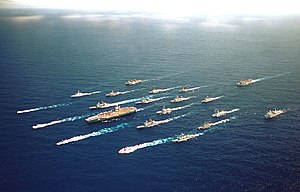Carrier battle group
A carrier battle group (CVBG) is a naval fleet that includes an aircraft carrier and a group of other ships that work together to help the carrier complete its mission. The CV in CVBG is the United States Navy classification code for an aircraft carrier.

The first naval fleets built around carriers were seen at the beginning of World War II. The Imperial Japanese Navy (IJN) was the first to put many carriers into one task force. This task force was used in the attack on Pearl Harbor. It was the IJN's main carrier battle group until four of its carriers were sunk at the Battle of Midway. The United States Navy deployed its carriers in separate formations. Each carrier was put with its own cruiser and destroyer escorts. These single-carrier fleets would often work together for certain assignments. The most notable examples of this are the Battle of the Coral Sea and Midway. By 1943, there was a large number of fleet and smaller carriers became available. This led to them using larger formations of three or four carriers. These groups became the Fast Carrier Task Force. They are the primary battle unit of the U.S. Third and Fifth Fleets.
With the construction of the large "supercarriers" of the Cold War era, the use of each carrier in a single formation was brought back. During this time, the main role of the CVBG in battle with the Soviet Union would have been to protect Atlantic supply routes between the United States and its NATO allies in Europe. The Soviet Union had no large carriers of its own. Aircraft carriers fighting each other would have been unlikely. A main mission of the Soviet Navy's attack submarines was to track every allied battle group. If war started, their mission was to sink the carriers. Knowing this, the CVBG put much of its resources in its own anti-submarine warfare mission.